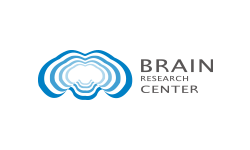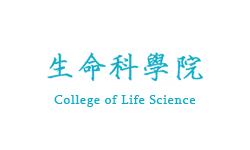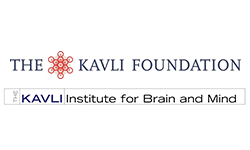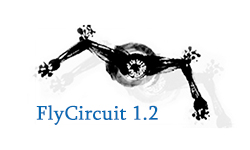Research
Research
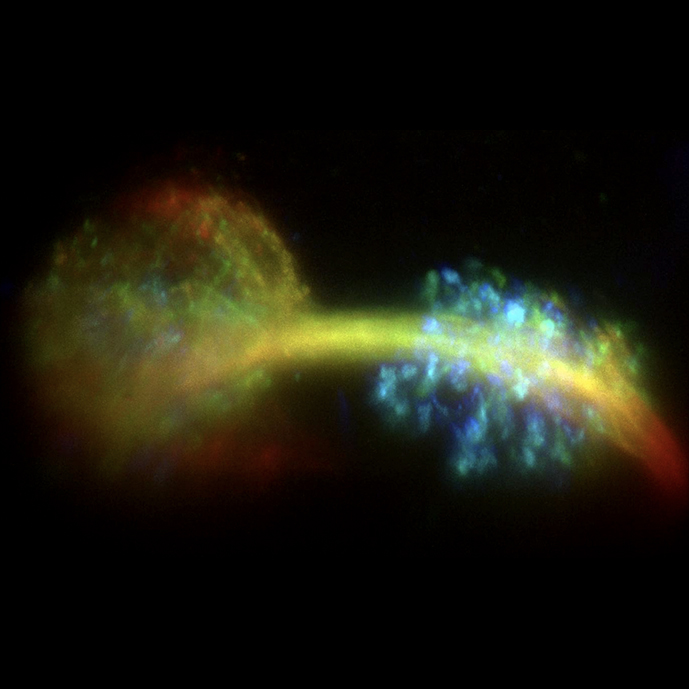
Functional Imaging 五維度層光功能性造影系統
To capture the activity of neuronal network, we extend our live imaging to three dimensions. We developed a 5D live imaging technology by Bessel Light-Sheet Microscopy. The beauty of this method is that we can capture living neuronal activities from soma to each synapse all at once in the whole brain with synapse resolution. With this cutting-edge technique, we can decode the responses at each synapse of olfactory projection neurons in Drosophila toward different odors and figure out how flies retrieve the temporal and spatial information from external stimulations.
為了更全面性的了解果蠅大腦的活動,我們最新的研究是將原本二維平面的活體影像,推進到三度空間的活體影像。我們發展了一套新的五維度層光功能性造影系統,能夠快速的擷取三度空間中,果蠅不同腦神經的功能變化。這套系統相較於過去的功能性造影系統,有著更快、看的範圍更大的優勢,讓原本許多無法被一起觀察的神經訊號,得以在同一個視野下呈現,這也讓我們能夠更全面的了解神經系統再遇到特定刺激下所產生的功能。我們利用了這套系統,已經成功的看到果蠅神經在不同嗅覺刺激下在空間以及時間上所展現的不同面貌。
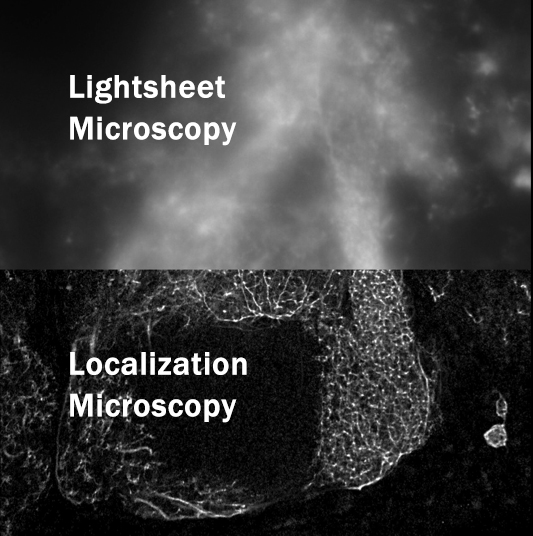
Super-Resolution Microscopy 超解析顯微鏡
Optical super-resolution microscopy allows nanoscale imaging of protein molecules in intact biological tissues. However, it is challenging to perform large volume super-resolution imaging for an entire animal organ. To overcome the aberrations in imaging thick tissues, we developed a single-wavelength Bessel Light-Sheet method, optimized for refractive-index matching with clarified specimens. Using spontaneous blinking fluorophores to label proteins of interest, we resolved the morphology of most, if not all, dopaminergic neurons in the whole adult brain (3.64 x 107 µm3) of Drosophila melanogaster at the nanoscale level and high imaging speed (436 µm3/sec).
超解析顯微鏡讓我們能夠看到過去一般光學顯微鏡無法解析的蛋白質,但目前要將這個技術應用在大腦組織上仍有許多挑戰。本中心團隊開發大組織用的超解析顯微鏡,能夠一次將整個果蠅大腦所有神經元都以超解析方式呈現。我們整合了層光顯微鏡技術、組織澄清透明技術,將閃爍的螢光分子標定在目標神經上,再利用客製化的電腦軟體進行計算,在一天內就能完成這樣的任務。
- 1.Chu LA#, Lu CH#, Yang SM, Liu YT, Feng KL, Tsai YCh, Chang WK, Wang WC, Chang SW, Chen P, Lee TK, Hwu YK, Chiang AS*, Chen BC* (2019) Rapid single-wavelength lightsheet localization microscopy for clarified tissue. Nature Communications 10, 4762. DOI: https://doi.org/10.1038/s41467-019-12715-3
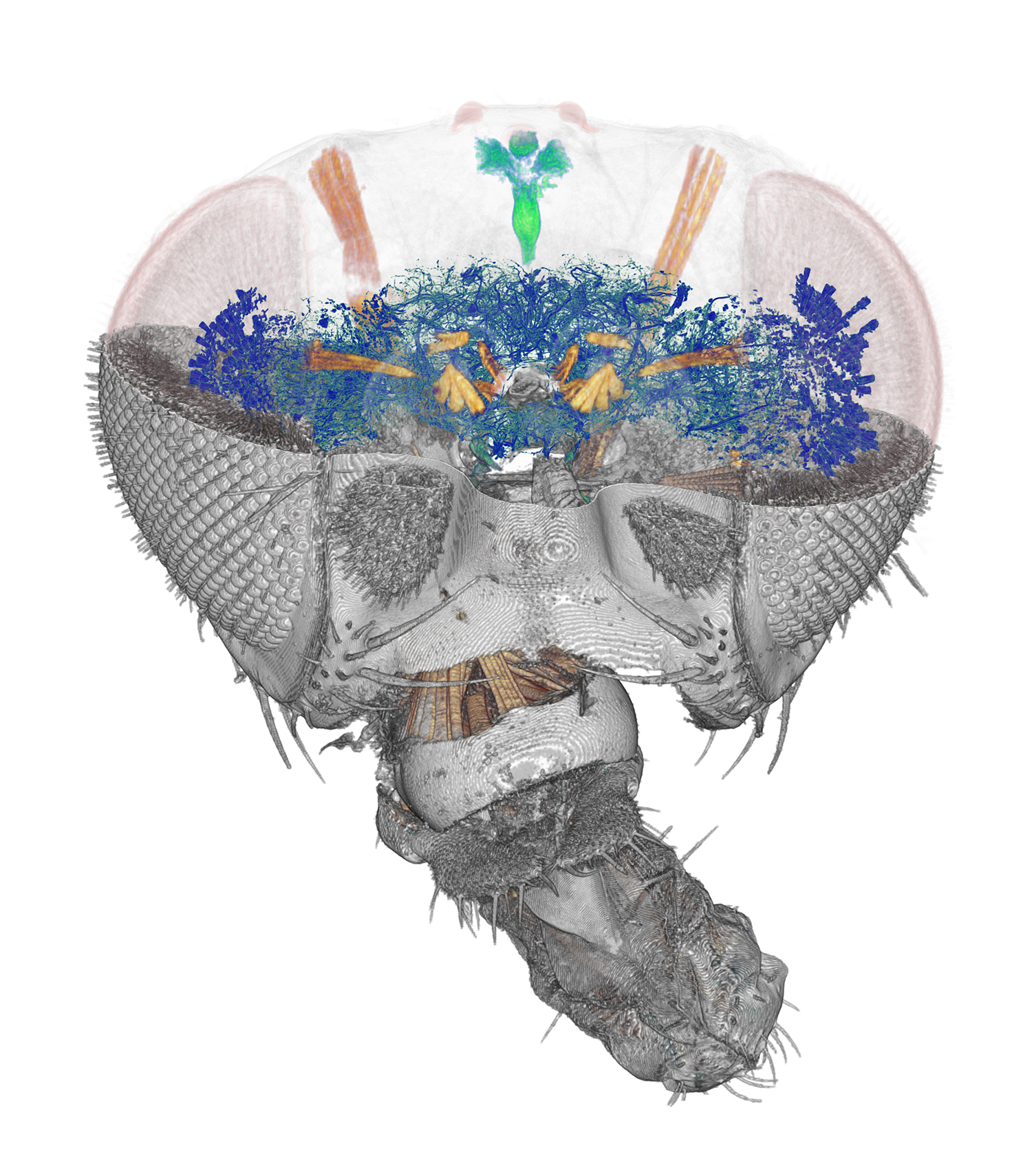
X-ray Tomography X光三維斷層掃描技術
Mapping comprehensive neural networks in the brain and the body is a formidable but essential to realize how nervous systems control complex behaviors. We develop an effective approach using integrated synchrotron X-ray tomography techniques for fast three dimensional (3D) imaging of a large population of metal-labeled individual neurons in Drosophila and mice without tissue clearing or physical sectioning. The integration of phase contrast, absorption contrast and high isotropic resolution ( < 0.5 µm in all dimensions) allows the 3D reconstruction of thousands of single neurons together with muscles and skeletons within a large volume. We validated the morphology of single neurons identified by X-rays with the comparable confocal images of fluorescence-labeled neurons. With in situ imaging and fast data acquisition, our approach provides a visual representation of the interior of a body at single-cell resolution, suitable for mapping neural networks in the whole animals within a realistic time frame.
我們利用同步輻射中心X光三維斷層掃描技術,來達成動物大腦的免切片破壞快速大體積的三維影像重組,觀察大腦神經在完整的果蠅頭殼內的空間關係,保存腦型與頭殼內肌肉與所有感官器官的相對空間關係與完整結構,經重金屬高基氏染色標定大群神經連結關係,並全部以各向同次微米等級的高解析度加以重組。我們解析分離出其中的單一神經元,與用螢光顯微鏡建立的果蠅腦神經型態資料庫加以比對。我們取得X光三維斷層掃描技術對於全身組織內神經型態資料解構在大體積快速取像的強大優勢,並以世界最高的解析度證明此技術能發揮其處理速度與處理樣品體積優勢,應用在動物大腦的神經細胞型態解析。 我們進一步發展新的基因表達酵素染色技術,使特定神經能被X光電腦斷層掃描成像及重組。我們建立出一套完整的染色流程,使果蠅腦內部神經訊號被提高且能被更準確定位。此新型染色法具有建構神經型態、標定細胞基因資訊與標定特定蛋白質空間位置資訊等應用性,有助X光電腦斷層掃描於未來神經科學研究發展。
- 1.Chin AL, Yang SM, Chen HH, Li MT, Lee TT, Chen YJ, Lee TK, Petibois C, Cai X, Low CM, Tan FCK, Teo A, Tok ES, Ong EBL, Lin YY, Lin IJ, Tseng YC, Chen NY, Shih CT, Lim JH, Lim J, Je JH, Kohmura Y, Ishikawa T, Margaritondo G*, Chiang AS*, Hwu YK* (2020) A synchrotron X-ray imaging strategy to map large animal brains. Chinese Journal of Physics 65; 24-32. DOI: https://doi.org/10.1016/j.cjph.2020.01.010
- 2.Hwu Y*, Margaritondo G* and Chiang AS* (2017) Q&A: Why use synchrotron x-ray tomography for multi-scale connectome mapping? BMC Biology 15:122, DOI: https://doi.org/10.1186/s12915-017-0461-8
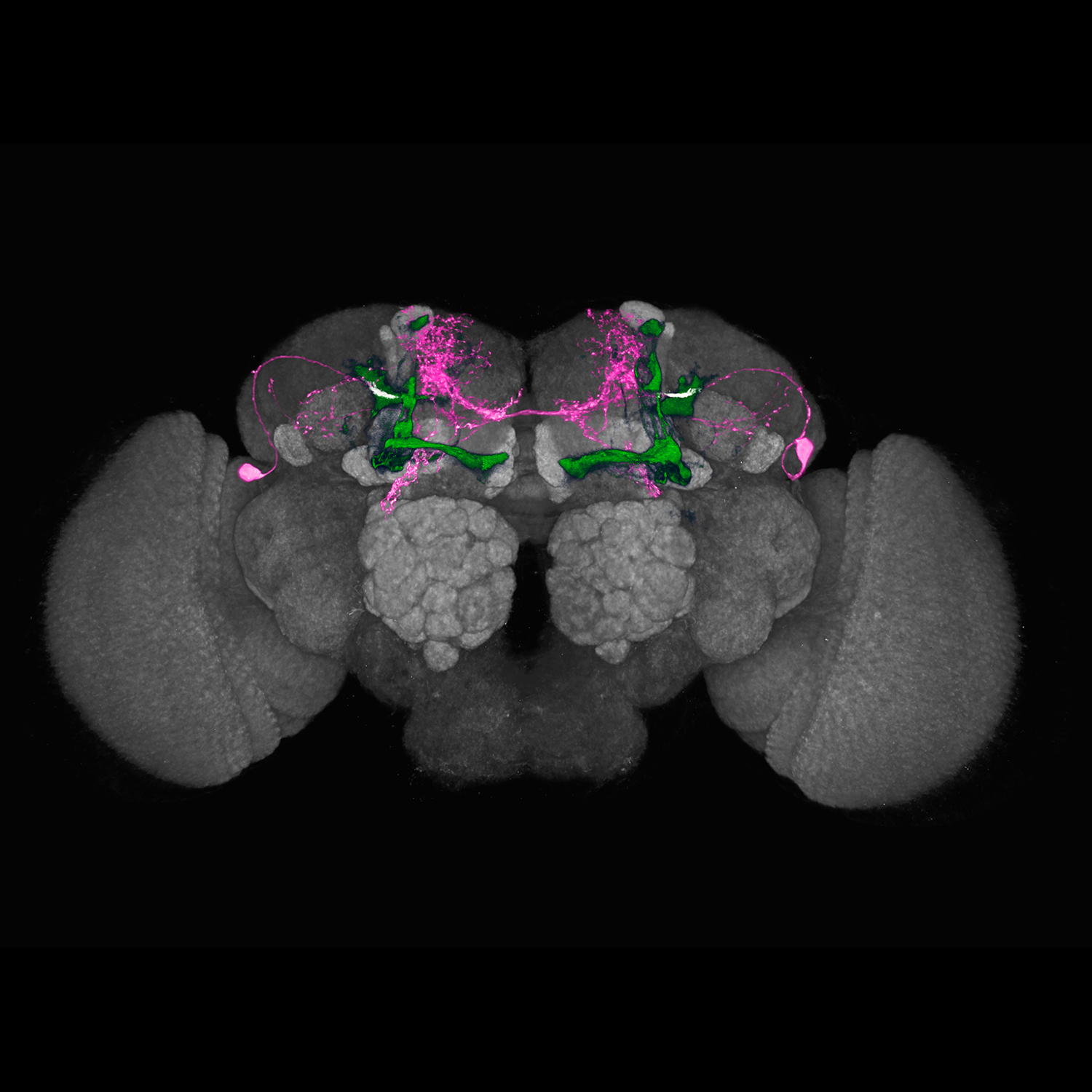
Memory Engram 全腦記憶的功能圖譜
About 100 years ago, the Nobel Prize winner in Physiology and Medicine in 1933, Thomas Hunt Morgan, began using Drosophila melanogaster as an animal model, which has the advantages of small size, easy feeding, and rapid reproduction. Due to the highly similar functional genes and proteins between Drosophila and mammals, Drosophila can be used as a model animal to study fundamental questions in neuroscience. The main research topic in learning and memory group is to understand how pairing external odor information with punishment or reward forms long-term memory in fruit flies. We are proceeding our research by looking for functions of memory-relevant genes, proteins, neurons and circuits. We believe that by understanding the gating mechanism of memory formation in simple animal models, we are getting closer to realize how the brain works.
距今約100年前,1933諾貝爾生理醫學獎得主摩根(Thomas Hunt Morgan) 開始使用黑腹果蠅 (Drosophila melanogaster) 做為實驗動物,利用其具有體積小、容易飼養、繁殖快等優點,研究遺傳學。由於果蠅與其他物種甚至人類都具有高度相似性的功能基因蛋白。便可以利用果蠅當做模式動物先驅,研究各種行為疾病。而由於記憶為腦之核心功能,學習與記憶組的主要工作內容就是使用果蠅來研究長期記憶,利用果蠅超強的嗅覺,讓他們學會有特殊的氣味出現時會被電到痛,當沒有電出現時,這個嗅覺記憶可以維持多久,然後剖析這種聯想式的記憶在果蠅上面是有哪些基因蛋白分子或是神經網路參與,進而了解果蠅形成長期記憶的原理機制;目標是以此分子與神經網路模型來解決人類遭遇到的記憶疾病,核心任務為建構一個完整的長期記憶形成和提取的全腦神經迴路圖譜。我們希望找尋對這個主題有熱情,願意投入解決人類重要問題的博士班學生。您將可以接觸到世界一流的科學研究。團隊主持人是清華大學江安世院士。江院士在國際上是研究神經科學首屈一指的科學家,我們同時與玉山學者Tim Tully一同研究,Tim Tully是學習與記憶研究領域的先驅,他們指導的學生有多篇著作發表在頂級期刊例如Science與Cell,於後續職涯中也都取得非常好的發展。
- 1.Lin HW, Chen CC, de Belle JS, Tully T, Chiang AS* (2021) CREBA and CREBB in two identified neurons gate long-term memory formation in Drosophila. Proc Natl Acad Sci USA 118, e2100624118. DOI: https://doi.org/10.1073/pnas.2100624118
- 2.Feng KL and Chiang AS* (2019) Forgetting memories through distinct actin remodeling mechanisms. Proc Natl Acad Sci USA 116, 20807–20808. DOI:
- 3.Chen CC, Wu JK, Lin HW, Pai TP, Fu TF, Wu CL, Tully T, Chiang AS* (2012) Visualizing long-term memory formation in two neurons of the Drosophila brain. Science 335, 678–685. DOI: https://doi.org/10.1126/science.1212735
- 4.Wu CL, Shih MF Lai SY, Yang HT, Turner GC, Chen L, Chiang AS* (2011) Heterotypic gap junctions between two neurons in the Drosophila brain are critical for memory. Curr Biol 21, 848-854. DOI: https://doi.org/10.1016/j.cub.2011.02.041
- 5.Lin HH, Lai JSY, Chin AL, Chen YC, Chiang AS* (2007) A map of olfactory representation in the Drosophila mushroom body. Cell 128, 1205-1218. DOI: https://doi.org/10.1016/j.cell.2007.03.006
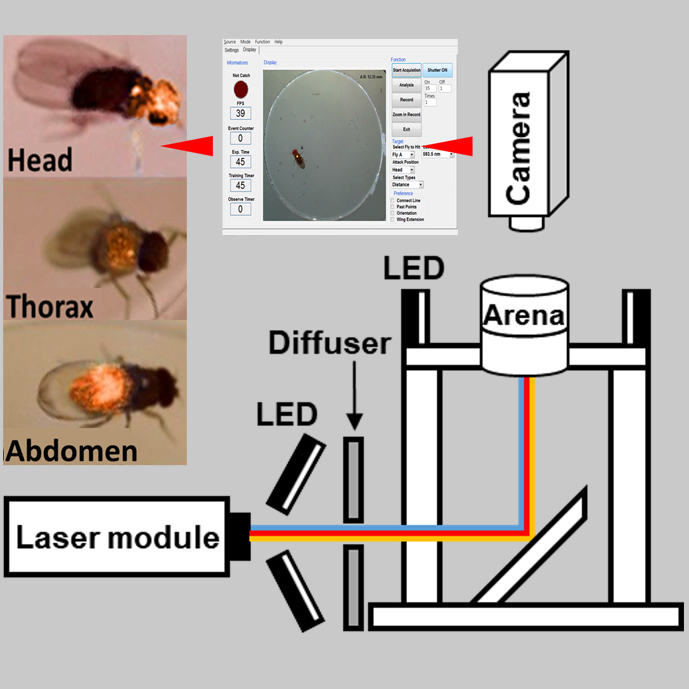
Behavior Manipulating System 果蠅即時行為分析與雷射追蹤系統
Understanding the function of neural circuits is one of the major issue in neuroscience. To reach this issue, we established an automated laser tracking and optogenetic manipulation system (ALTOMS). The intelligent central control module in ALTOMS integrates two major functions: high-speed fly behavior analysis and laser targeting. These functions make it possible to target the laser on designated region of a free-moving individual fly in real-time. Combining ALTOMS with optogenetic tools, we can investigate the functions of neural circuits for memory, pain, and locomotion behaviors.
瞭解神經網路的功能是神經科學領域的重要課題,而調控神經活性與行為觀察是探討神經網路功能的基礎。為此我們發展了即時影像分析控制暨雷射追蹤系統(ALTOMS),其具有智能中央控制模組能高速分析果蠅行為並控制雷射模組,使雷射精準照射在果蠅的頭部、胸部或腹部,並搭配光遺傳學工具以活化/抑制特定神經的活性,幫助我們探討學習記憶、痛覺、個體運動時的神經運作,理解神經的作用機制。


